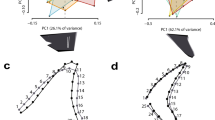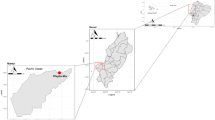Abstract
Size measurements are crucial for studies on the growth, maturation, maximum size, and population structure of cartilaginous fishes. However, researchers use a variety of measurement techniques even when working on the same species. Accurate comparison of results among studies is only possible if the measurement technique used is adequately defined and, if different techniques are used, a conversion equation can be derived. These conditions have not always been met, leading to invalid comparisons and incorrect conclusions. This paper reviews methods used for measuring chondrichthyans, and summarises the variety of constraints that influence the choice of a measurement technique. Estimates of the variability present in some measurement techniques are derived for shortfin mako shark, Isurus oxyrinchus, porbeagle shark, Lamna nasus, blue shark, Prionace glauca, Antarctic thorny skate, Amblyraja georgiana, and Pacific electric ray, Torpedo californica. Total length measured with the tail in the natural position (sharks) and disc widths (batoids) have higher variability than other methods, and are not recommended. Instead, the longest longitudinal axis should be measured where possible and practical; i.e., flexed total length for sharks, total length for batoids (excluding suborder Myliobatoidei), pelvic length for batoids of the suborder Myliobatoidei, and chimaera length (snout to posterior end of supracaudal fin) for chimaeroids (except for Callorhinchus, for which fork length should be measured from the anterior edge of the snout protuberance). Straight-line measurements are preferred to measurements over the curve of the body. Importantly, measurement methods must be clearly defined, giving information on the anterior reference point, the posterior reference point, and how the measurement was made between these two. Measurements using at least two different methods are recommended on at least a subsample of the fish in order to develop conversion regression relationships.
Similar content being viewed by others
References
Bass AJ (1973) Analysis and description of variation in the proportional dimensions of scyliorhinid, carcharhinid and sphyrnid sharks. Oceanographic Research Institute Investigational Report 32, 28 pp
Bass AJ, D’Aubrey JD, Kistnasamy N (1975) Sharks of the east coast of southern Africa. IV. The families Odontaspididae, Scapanorhynchidae, Isuridae, Cetorhinidae, Alopiidae, Orectolobidae and Rhiniodontidae. Oceanographic Research Institute Investigational Report 39, 102 pp
Bigelow HB, Schroeder WC (1948) Fishes of the Western North Atlantic. Part 1. Lancelets, cyclostomes, sharks. Mem Sears Found Mar Res 1:59–546
Calis E, Jackson EH, Nolan CP, Jeal F (2005) Preliminary age and growth estimates of the rabbitfish, Chimaera monstrosa, with implications for future resource management. J Northw Atl Fish Sci 35:15–26
Campana SE, Marks L, Joyce W (2005) The biology and fishery of shortfin mako sharks (Isurus oxyrinchus) in Atlantic Canadian waters. Fish Res 73:341–352
Casey JG, Pratt HL, Stillwell CE (1985) Age and growth of the sandbar shark (Carcharhinus plumbeus) from the western North Atlantic. Can J Fish Aquat Sci 42:963–975
Chan RWK (2001) Biological studies on sharks caught off the coast of New South Wales. PhD Thesis, University of New South Wales, Sydney, 323 pp
Cliff G, Dudley SFJ (1992) Sharks caught in the protective gill nets off Natal, South Africa. 6. The copper shark Carcharhinus brachyurus (Günther). S Afr J Mar Sci 12:663–674
Cliff G., Dudley SFJ, Davis B (1990) Sharks caught in the protective gill nets off Natal, South Africa. 3. The shortfin mako shark Isurus oxyrinchus (Rafinesque). S␣Afr J Mar Sci 9:115–126
Coakley A (1973) A study in the conservation of elephant fish (Callorynchus milii, Bory) in New Zealand. New Zealand Marine Department Fisheries Technical Report 126, 22 pp
Compagno L, Dando M, Fowler S (2005) Sharks of the world. Princeton University Press, Princeton, 368 pp
Compagno LJV (1984) Sharks of the world. An annotated and illustrated catalogue of shark species known to date. FAO Fish Synop 125(4):655
Di Giácomo EE, Perier MR (1994) Reproductive biology of the cockfish, Callorhynchus callorhynchus (Holocephali: Callorhynchidae), in Patagonian waters (Argentina). Fish Bull 92:531–539
Didier DA (1995) Phylogenetic systematics of extant chimaeroid fishes (Holocephali, Chimaeroidei). American Museum Novitates (3119), 86 pp
Didier DA (2002) Two new species of chimaeroid fishes from the southwestern Pacific Ocean (Holocephali, Chimaeridae). Ichthyol Res 49:299–306
Duffy C, Francis MP (2001) Evidence of summer parturition in shortfin mako (Isurus oxyrinchus) sharks from New Zealand waters. N Z J Mar Freshw Res 35:319–324
Francis MP (1997) Spatial and temporal variation in the growth rate of elephantfish (Callorhinchus milii). N Z J Mar Freshw Res 31:9–23
Francis MP, Francis RICC (1992) Growth rate estimates for New Zealand rig (Mustelus lenticulatus). Aust J Mar Freshw Res 43:1157–1176
Francis MP, Ó Maolagáin C, Stevens D (2001) Age, growth, maturity, and mortality of rough and smooth skates (Dipturus nasutus and D. innominatus). New Zealand Fisheries Assessment Report 2001/17, 21 pp
Francis MP, Stevens JD (2000) Reproduction, embryonic development and growth of the porbeagle shark, Lamna nasus, in the south-west Pacific Ocean. Fish Bull 98:41–63
Freer DWL, Griffiths CL (1993) Estimation of age and growth in the St Joseph Callorhinchus capensis (Dumeril). S Afr J Mar Sci 13:75–81
Gilmore RG, Dodrill JW, Linley PA (1983) Reproduction and embryonic development of the sand tiger shark, Odontaspis taurus (Rafinesque). Fish Bull 81:201–225
Gould SJ (1966) Allometry and size in ontogeny and phylogeny. Biol Rev Camb Philos Soc 41:587–640
Hubbs CL, Ishiyama R (1968) Methods for the taxonomic study and description of skates (Rajidae). Copeia 1968:483–491
Ishiyama R (1951) Studies on the rays and skates belonging to the family Rajidae, found in Japan and adjacent regions. 2. On the age-determination of Japanese black-skate Raja fusca Garman (preliminary report). Bull Jpn Soc Sci Fish 16:112–118
Johnson AG, Horton HF (1972) Length-weight relationship, food habits, parasites, and sex and age determination of the ratfish, Hydrolagus colliei (Lay and Bennett). Fish Bull 70:421–429
Joung S-J, Hsu H-H (2005) Reproduction and embryonic development of the shortfin mako, Isurus oxyrinchus Rafinesque, 1810, in the northwestern Pacific. Zool Stud 44:487–496
Kohler NE, Casey JG, Turner PA (1995) Length-weight relationships for 13 species of sharks from the western North Atlantic. Fish Bull 93:412–418
Last PR, Stevens JD (1994) Sharks and rays of Australia. CSIRO, Hobart, 513 pp
Luchetti E (2004) Aspects de la biologie de Chimaera monstrosa L. (Holocephali: Chimaeridae) en Atlantique Nord-Est. J Rech Oceanogr 29:40
MacNeil M.A, Campana SE (2002) Comparison of whole and sectioned vertebrae for determining the age of young blue shark (Prionace glauca). J Northw Atl Fish Sci 30:77–82
McArdle BH (1988) The structural relationship: regression in biology. Can J Zool 66:2329–2339
Mollet HF, Cailliet GM (1996) Using allometry to predict body mass from linear measurements of the white shark. In: Klimley AP, Ainley DG (eds) Great white sharks. The biology of Carcharodon carcharias. Academic Press, San Diego, pp 81–89
Moura T, Figueiredo I, Machado PB, Gordo LS (2004) Growth pattern and reproductive strategy of the holocephalan Chimaera monstrosa along the Portuguese continental slope. J Mar Biol Assoc UK 84:801–804
Natanson LJ, (1993) Effect of temperature on band deposition in the little skate, Raja erinacea. Copeia 1993:199–206
Natanson LJ, Casey JG, Kohler NE, Colket T (1999) Growth of the tiger shark, Galeocerdo cuvier, in the western North Atlantic based on tag returns and length frequencies; and a note on the effects of tagging. Fish Bull 97:944–953
Notarbartolo-di-Sciara G (1987) A revisionary study of the genus Mobula Rafinesque, 1810 (Chondrichthyes: Mobulidae) with the description of a new species. Zool J Linn Soc 91:1–91
Pratt HL (1979) Reproduction in the blue shark, Prionace glauca. Fish Bull 77:445–470
Ricker WE (1973) Linear regressions in fishery research. J Fish Res Board Can 30:409–434
Skomal GB, Natanson LJ (2003) Age and growth of the blue shark (Prionace glauca) in the North Atlantic Ocean. Fish Bull 101:627–639
Sullivan KJ (1977) Age and growth of the elephant fish Callorhinchus milii (Elasmobranchii: Callorhynchidae). N Z J Mar Freshw Res 11:745–753
Acknowledgments
I thank Clinton Duffy and Silver Bishop for help in collecting the New Zealand competition shortfin mako data, and the New Zealand Ministry of Fisheries and CCAMLR observers for collecting the New Zealand tuna longline mako data and the Ross Sea Antarctic thorny skate data. Steve Campana kindly provided the porbeagle and blue shark data, and Julie Neer the Pacific electric ray data. Enzo Acuña (Universidade Catolica del Norte, Coquimbo, Chile), Valentin Buencuerpo (Universidade Complutense de Madrid, Madrid, Spain) and Rand Rasmussen (NMFS, La Jolla, California, USA) allowed me to use their unpublished shortfin mako regression equations. Chris Francis provided invaluable statistical advice. I appreciate the numerous helpful discussions with many colleagues over recent years that helped shape some of the ideas and work in this paper; they included John Carlson, Jon Dodrill, Dave Ebert, Peter Kyne, Skip McKinnell, Henry Mollet, Lisa Natanson, Julie Neer, Wes Pratt, Sue Smith, John Stevens, and William White.
Author information
Authors and Affiliations
Corresponding author
Rights and permissions
About this article
Cite this article
Francis, M.P. Morphometric minefields—towards a measurement standard for chondrichthyan fishes. Environ Biol Fish 77, 407–421 (2006). https://doi.org/10.1007/s10641-006-9109-1
Received:
Accepted:
Published:
Issue Date:
DOI: https://doi.org/10.1007/s10641-006-9109-1




